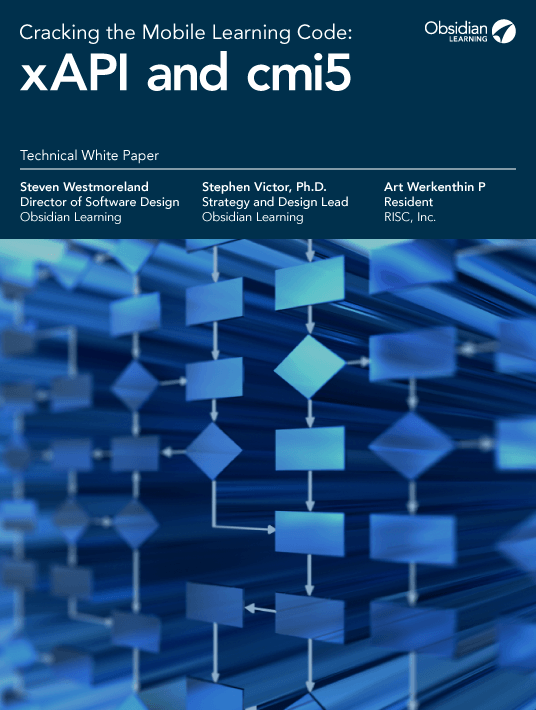xAPI And Cmi5: How To Crack The Mobile Learning Code
Here is an overview of how using xAPI and cmi5 can take your mobile learning to the next level:
Mobile technology use is continually increasing, making it possible for us to connect to both information and other people in remarkable ways. Mobile learning (mLearning) allows learning and performance support at any time and in any location. Mobile learning is a key component of a distributed learning strategy. In an earlier white paper, we noted that distributed learning should be:
- Fully learner-centered, engaging the learner not only in periods of formal training but also in times of need in the workplace. Distributed learning provides support for the full spectrum of learning and performance support, from formal to informal.
- Blended and targeted to the unique needs of the adult learner. Learning should be ongoing, occur when needed, and make use of inexpensive (if not open) technologies.
- Designed to provide opportunities for collaboration and interaction -both within formal learning experiences and continuing in the workplace- in the form of collaborative problem-solving, ongoing performance support, and communities of practice.

Mobile learning technologies can be powerful tools to support mobile, social learning. Often in mobile learning, the traditional WBT-type course may not be the ideal solution. Mobile learning can include performance support systems, brief tutorials, checklists, videos, teleconferencing (chat), and microlearning.
Learning Isn't Always In The Classroom
The current standard for eLearning-to-LMS (Learning Management System) communication is SCORM, the Shareable Content Object Reference Model. The history of LMS-to-content communication goes back over 20 years, to 1993. That was the year the Aviation Industry Computer-Based Training Committee (AICC) released “CMI Guidelines for Interoperability”, originally a file-based specification for desktops but later revised to include web browsers.
Traditionally, we have used the SCORM-based Learning Management System to host and distribute learning content, track learner usage, and generate reports. The Learning Management System can capture courses completed, passing scores achieved, and certificates earned; but it cannot track, for example, engagements with interactive museum displays. However, there is value in capturing both formal and informal learning in the workplace.
Formal Learning
As its name suggests, formal learning is learning that occurs in an organized, deliberate fashion. This is what we ordinarily consider part of the learning and development function in most organizations: Instructor-led training, eLearning, and so forth. This is the type of learning we usually deliver on the Learning Management System.
Informal Learning
Informal learning is learning that occurs outside the classroom, online course, or other formal setting. While mobile learning experiences can be used to support informal learning in the workplace, informal learning is not easily captured in the traditional SCORM-driven Learning Management System.
xAPI And Cmi5: Bridging The Gap Between Formal And Informal Learning
And now, with the recent maturing of the xAPI and cmi5 standards, we soon won’t be so firmly tied to the Learning Management System - and we can track and report on both formal and informal learning experiences. We still need to manage learning records, of course, but the ways we do that are changing. The “mobile SCORM” toward which Learning Management System vendors are moving are xAPI and cmi5, which will ultimately replace SCORM for support of mobile applications.
The xAPI Standard
We've been hearing a lot about xAPI lately. What is it exactly? xAPI was released in 2013. In and of itself, xAPI does not replace everything SCORM does. At its core, xAPI is a data transport and storage mechanism. Of all the functions provided by the Learning Management System and SCORM, xAPI provides only one: Learning record management.
xAPI is not designed for scheduling, sequencing, bookmarking, user management, and so on. To be able to use xAPI as the basis for a new SCORM, we need to add a few rules to ensure consistency across systems. The answer to this dilemma is cmi5.
The Cmi5 Standard
The cmi5 specification defines how learning content is imported, launched, and tracked by the Learning Management System using an xAPI LRS. It was developed with these goals:
- Interoperability.
A cmi5 assignable unit should work the same across all Learning Management Systems that support the specification. Think of the SCORM package, where a Learning Management System imports a SCORM course. Cmi5 has a similar import specification, but with cmi5 it is possible to import only the course structure, not the actual content. This means the content can reside anywhere - behind a firewall, as an app on a mobile device, on a content distribution network, etc. - Extensibility.
Unlike SCORM, the data cmi5 tracks are not limited. Since cmi5 is based on xAPI it supports extensions. You can also track binary data like videos, pictures, and audio clips. You can even share data across multiple assignable units. - Mobile Support.
Here again, cmi5 benefits from xAPI; since the base communication mechanism handles mobile devices, so does cmi5.
Want To Learn More?
In this brief article, we've only given you a taste of the capabilities of xAPI/cmi5 and how they can be used in mLearning. The latest white paper from Obsidian Learning (co-authored with Art Werkenthin of RISC, Inc.) discusses how mobile technologies can support both formal and informal learning in ILT, WBT, blended learning, and on-the-job performance support. It also addresses global trends in mobile technology use, and presents examples of novel applications of mobile learning. Finally, it provides a technical overview of xAPI and cmi5 and examines how these technologies can be used to capture the entire spectrum of learning, from formal to informal.
To learn more about mobile learning, xAPI, and cmi5, please download our paper here: Cracking the Mobile Learning Code: xAPI and cmi5.
Related Article:
Image Credits: Ilya Pavlov









